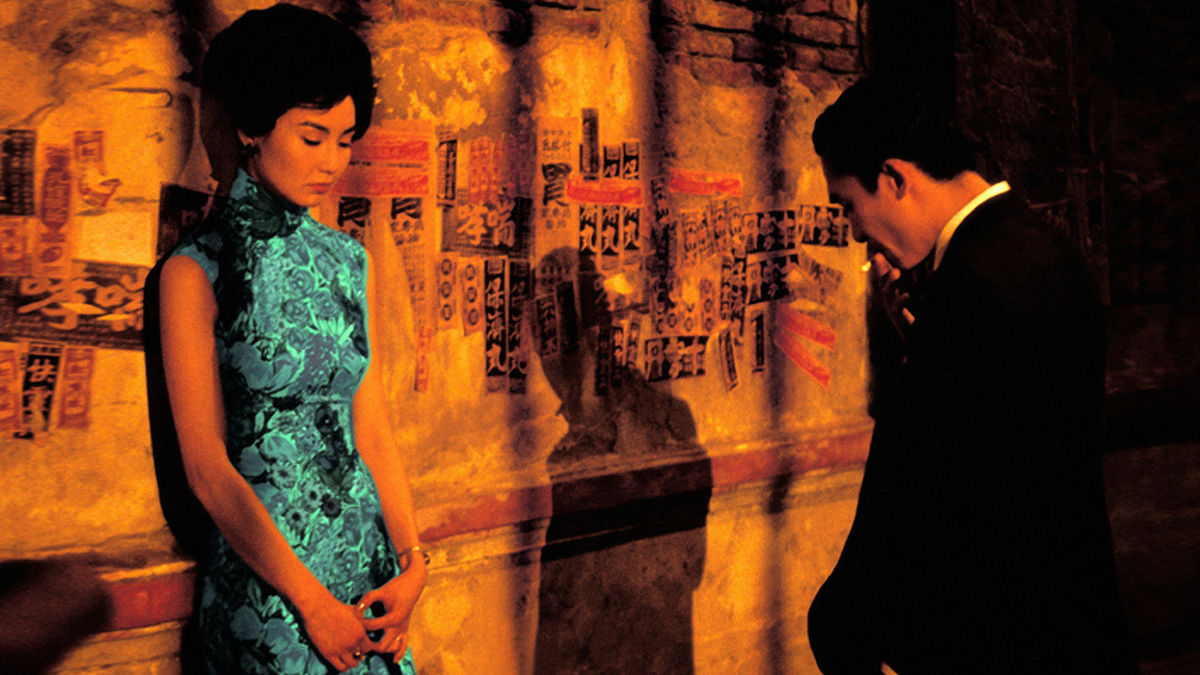In this section of our Colossus Movie Guide for In the Mood for Love, we look at the key shots that help us understand the film.
Cast
- Maggie Cheung – Su Li-zhen (Mrs. Chan)
- Tony Leung – Chow Mo-wan
- Siu Ping Lam – Ah Ping
- Rebecca Pan – Mrs. Suen
- Kelly Lai Chen – Mr. Ho
- Joe Cheung – man living in Mr. Koo’s apartment
- Chan Man-Lei – Mr. Koo
- Chin Tsi-ang – Suen’s female servant
- Roy Cheung – Mr. Chan (voice)
- Paulyn Sun – Mrs. Chow
- Wong Kar-wai – Writer and director
Key shots of In the Mood for Love
The slow-motion shots
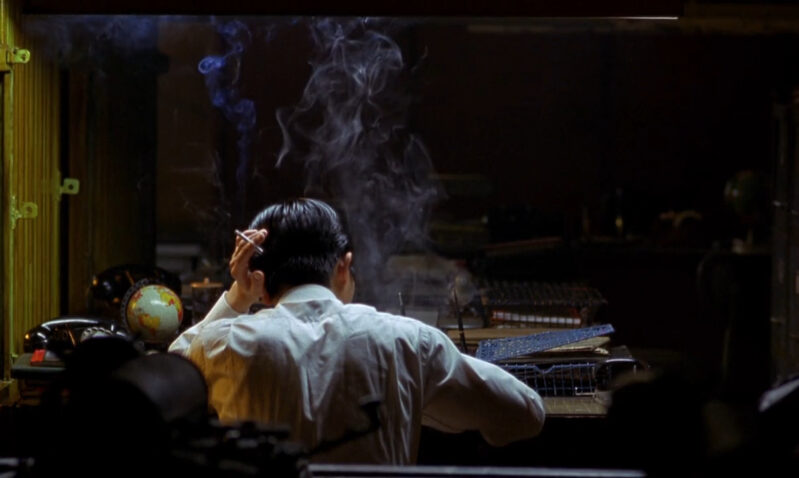
Slo-mo shots are a distinct aesthetic feature in In the Mood for Love, enhancing the film’s visual language and further illuminating its themes. In particular, the scenes where Chow smokes and the smoke slowly floats into the air exemplify the interplay between the film’s aesthetics and themes.
The slow-motion shots in the film imbue the narrative with a sense of timelessness and a lingering feeling of longing. These shots decelerate the flow of time, allowing the audience to absorb and reflect on the emotions and tensions present in each frame. They mirror the internal states of the characters—time seems to slow down for Chow and Su as they dwell in their unfulfilled desires and unexpressed emotions.
The scenes where Chow smokes are especially evocative. Here, the slow-motion effect emphasizes the smoke’s graceful ascent into the air, creating an ethereal and dreamlike quality. This not only enriches the visual appeal of these scenes but also serves as a metaphor for the characters’ desires and longings. The rising smoke signifies their unexpressed feelings, which, like smoke, are ephemeral and elusive—present, yet intangible. It reflects the transient nature of their relationship—like smoke, it exists in a moment, then vanishes, leaving behind only a trace.
Su sitting behind Mr. Chan

The shot of Su sitting behind her husband, as Mrs. Suen and her friends engage in a lively game of Mahjong, is laden with symbolism and contributes significantly to the film’s deeper meaning.
In this shot, we never see the face of Su’s husband or Mrs. Chow. Their absence and anonymity underscore the emotional disconnect between Su and her husband, and between Chow and his wife. This absence not only reflects the physical distance between the spouses but also highlights the emotional gap and lack of understanding in their relationships. The fact that we never see their faces symbolizes the impersonal nature of their marriages, marked more by societal expectations than personal intimacy. (Also note that we never see Mrs. Chow’s face either. So all of those same dynamics apply to Chow’s situation life as well.)
Su’s position in the background, detached from the group, signifies her emotional isolation and the societal constraints she experiences as a woman. As she watches the Mahjong game, she is confined to the role of a spectator, mirroring her role in society where she must abide by the rules without actively participating in shaping her destiny.
The Mahjong game itself serves as a motif, symbolizing the societal norms and expectations that govern the characters’ lives. The game’s rules and strategies parallel the societal rules that the characters must adhere to, restricting their personal desires and aspirations.
From an aesthetic standpoint, the shot is masterfully composed, with Su’s isolated figure juxtaposed against the lively Mahjong players. The contrast between Su’s silence and the players’ animated chatter amplifies the sense of her emotional solitude and longing.
The presence of clocks
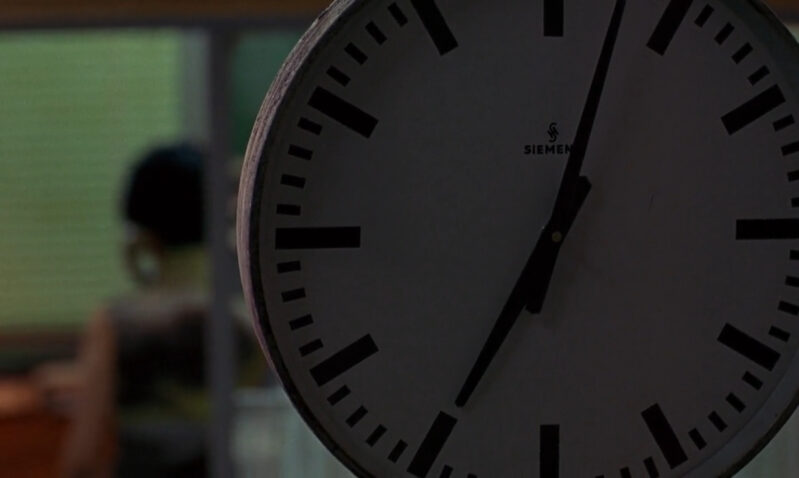
Clocks are a significant motif in In the Mood for Love, their recurrent presence in the film serving to underscore its exploration of time, memory, and unfulfilled desires.
In Su’s and Chow’s respective offices, the conspicuous placement of clocks suggests the omnipresence of time in their lives, both professionally and personally. In a professional context, the clock signifies the structure and routine of their work lives—each tick marking the passage of another moment in a day filled with mundane tasks and responsibilities.
However, the symbolism of the clocks extends beyond the characters’ professional lives. In a deeper sense, the clocks serve as a constant reminder of the fleeting nature of time—a theme that resonates throughout the film. As Su and Chow grapple with their unexpressed feelings for each other, the ticking clocks underscore the passing moments that they cannot reclaim, thus heightening the sense of longing and loss that permeates their relationship.
Additionally, the clocks in the film contribute to the theme of memory. Each tick of the clock is a moment consigned to the past—a memory. The presence of clocks in Su’s and Chow’s offices signifies the accumulation of these memories over time, with some moments more significant than others. This aligns with the film’s exploration of the blurry line between past and present, and how our memories shape our current experiences and emotions.
The tight alleyway
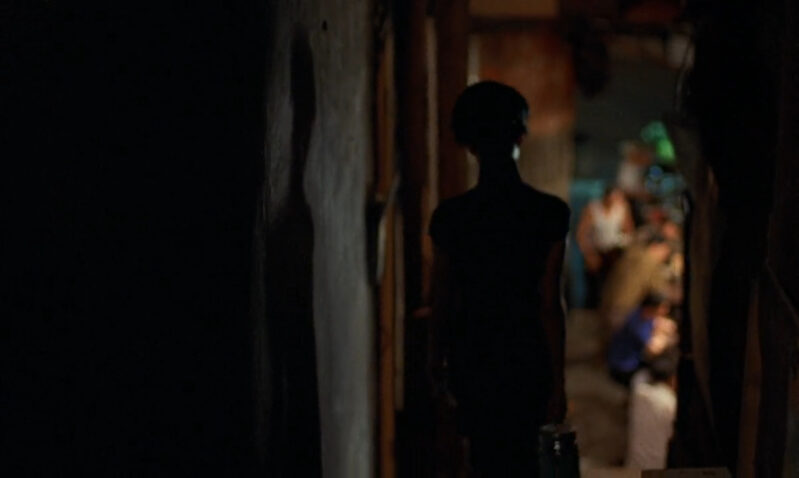
The alleyway where Su and Chow purchase their noodles becomes an essential setting in In the Mood for Love, contributing significantly to the film’s ambiance and narrative tension. This narrow, crowded space plays a crucial role in both the aesthetic composition of the film and the complex relationship between the two main characters.
Aesthetically, the alleyway scene epitomizes Wong Kar-wai’s signature visual style. The scene is shot with a narrow depth of field, focusing on the characters while the background remains blurred. This cinematographic technique heightens the emotional intimacy of the scene, isolating Su and Chow in a world that seems detached from their surroundings. The scene’s color palette, characterized by deep, saturated hues, adds a sense of warmth and nostalgia, complementing the film’s exploration of memory and longing.
The atmosphere of the alleyway—its crowdedness, the ambient noise, the flurry of activity—contrasts with the solitude and silence of Su and Chow’s personal lives. This contrast enhances the film’s pervasive mood of melancholy and unexpressed desire. The bustling, lively atmosphere of the alleyway also mirrors the chaos and confusion of their emotional lives, further reinforcing the film’s themes.
The tension between Su and Chow in the alleyway is palpable. As they pass each other in this narrow passageway, there’s a sense of anticipation and suppressed emotions. Despite their physical proximity, there remains an unbreachable distance between them, reflecting their self-imposed emotional restraint. This tension is amplified by the tight framing of the shot, which traps the characters within the confines of the screen—much like the societal norms and personal codes of conduct that trap them in their respective lives.
Su crying into Chow’s shoulder
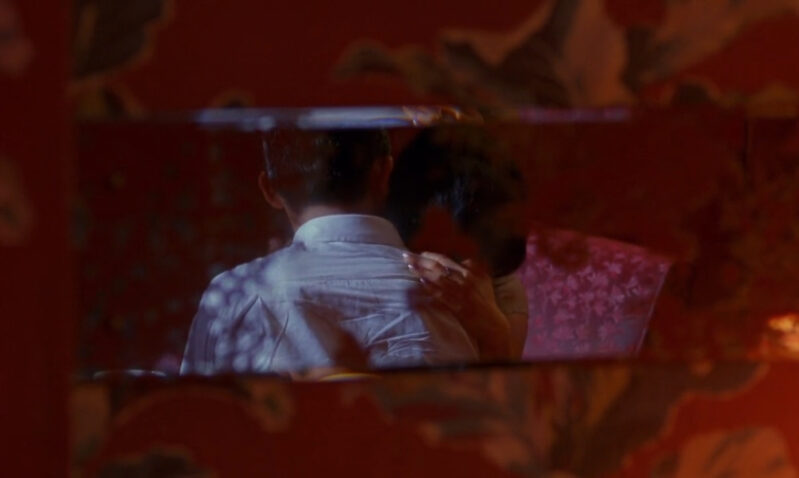
The scene where Su cries into Chow’s shoulder, viewed through a mirror reflection adorned with red flowers, is a powerful representation of the emotional complexities in In the Mood for Love. This shot skillfully combines aesthetic design and thematic narrative to deliver an impactful visual metaphor.
Viewing this intimate moment through a mirror enhances its emotional resonance, amplifying the sense of voyeurism and adding an extra layer of distance between the characters and the audience. The mirror, much like the earlier discussed scene, becomes a barrier, an interface that simultaneously connects and separates. It reflects the intricate dynamics of Su and Chow’s relationship—close yet distant, familiar yet alienated.
The red flowers on the mirror and the wallpaper imbue this scene with a symbolic depth. In Chinese culture, red often symbolizes love and passion, but also can denote danger or warning. In this context, the red flowers reflect the love and longing between Su and Chow, but they also signify the risks associated with their feelings—risks of societal judgement, emotional vulnerability, and potential heartbreak.
Furthermore, the reflection of Su crying into Chow’s shoulder amid the red flowers can be interpreted as a poignant encapsulation of their unfulfilled love—beautiful, passionate, but ultimately constrained and reflected back onto themselves.
The alleyway bars
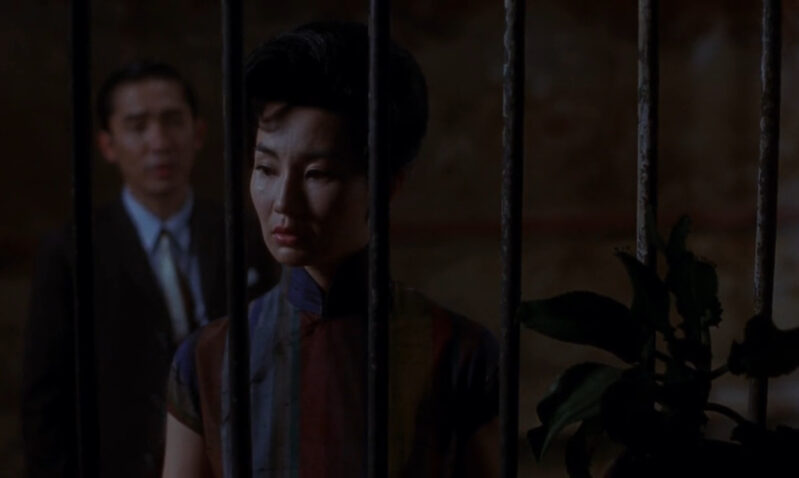
Several shots in In the Mood for Love show Chow and Su standing in the alleyway, often with bars serving as an integral part of the frame. These shots, along with the symbolic use of bars, provide an insightful glimpse into the characters’ emotional states and the film’s overarching themes.
In these scenes, the alleyway transforms into a metaphorical space that reflects the emotional and societal constraints that both characters experience. The narrow passageway mirrors the limited room that Chow and Su have to navigate their feelings within the rigid societal norms that define their lives.
The bars, which often appear in the foreground, function symbolically as prison bars, trapping the characters within the frames. These bars emphasize the characters’ emotional imprisonment—their unexpressed desires and emotions are confined within themselves, much like prisoners behind bars. Furthermore, the bars visually divide the frame, mirroring the invisible barriers that separate Chow and Su, preventing them from acknowledging and acting on their feelings.
From an aesthetic standpoint, these shots featuring the alleyway and bars showcase Wong Kar-wai’s masterful use of framing and depth of field to visually convey the film’s themes. The juxtaposition of the characters against the confined spaces and the obstructing bars enhances the feeling of longing and the sense of the unattainable that define their relationship.
Chow’s whisper into the hollow
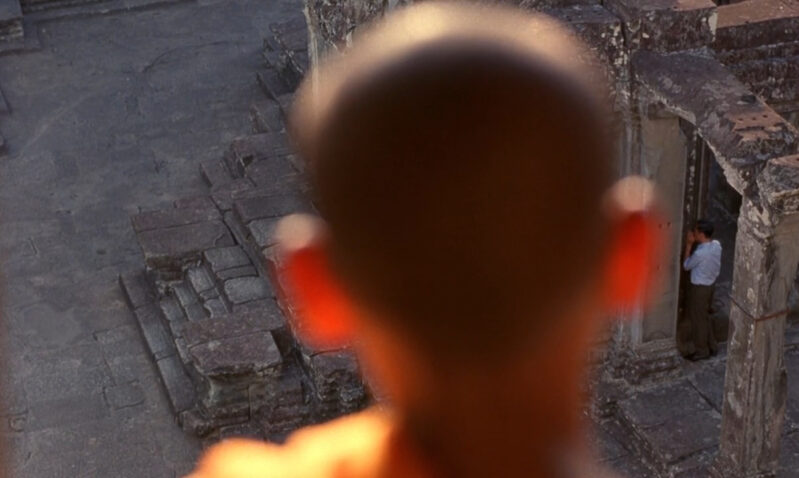
The shot where Chow whispers into a hollow at Angkor Wat is a climactic moment in In the Mood for Love, encapsulating the thematic essence of the film within its symbolic setting. The detailed aspects of this scene—the setting, the act of whispering, and the observing monk—intertwine to form a profound commentary on the film’s exploration of unexpressed emotions, memory, and time.
Angkor Wat, an ancient temple complex, presents an intriguing backdrop for this scene. Its timeless nature juxtaposes with the fleeting moments and transitory emotions that define Chow and Su’s relationship. As Chow whispers into the hollow, he is, in essence, entrusting his secret into the timeless relic of the past, symbolically connecting the ephemeral to the eternal.
Whispering into the hollow is an act of catharsis for Chow, a way to externalize his unexpressed feelings without the risks associated with direct disclosure. It serves as a metaphor for the film’s exploration of unfulfilled love and the secrets we keep to navigate societal norms and personal boundaries.
The observing monk in the distance adds an intriguing dimension to the scene. His silent presence suggests a form of detached observation and understanding, much like the audience’s role throughout the film. His non-intrusive observation parallels our engagement with Chow and Su’s story, emphasizing the themes of observation, interpretation, and understanding in the process of storytelling.
What are your thoughts?
Are there more shots you think should be part of the Colossus Movie Guide for In the Mood for Love? Leave your thoughts below and we’ll consider adding them.

